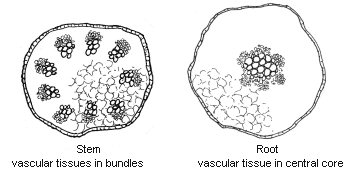In some cases, roots look similar to stems—so what's the difference? It's
tempting to say that stems are above ground, and roots below ground—but that's not
entirely accurate. (See sidebar.) One simple difference is that stems bear leaves, and
roots don't. Here are some other, less obvious, ways to distinguish stems from roots. Similarity: Both stems and roots contain vascular
tissues (xylem and phloem), the circulatory system of the plant.
Difference: In herbaceous stems, the
vascular tissues are contained in bundles; these bundles sit relatively near the surface
of the stem. In roots, the vascular tissues form a central core—a location where
they're protected from the harsh activity of pushing through soil. (We are referring to
young, non-woody tissues.)
Comparison of Stem and Root Cross-Sections

Similarity: Both stems and roots are able
to initiate lateral growth: that is, to form "branches."
Difference: In stems, side branches
arise from axillary buds. These buds are located at the nodes in the leaf axil (the point
where the leaf attaches to the stem).
Lateral roots, on the other hand, arise from deep within
the root's tissue, near the central core. Roots don't have nodes, and they don't have
buds.
|
|

Role reversal
Though most stems
are above ground, and most roots are underground, this isn’t always the case.
Consider the following underground plant parts:
--potato tuber
--iris rhizome
--tulip bulb
--gladiolus corms
We may think of them
as roots, and in many ways they perform the same functions as roots, but, technically
speaking, these are all modified underground stems.
Have you ever noticed the little
aerial roots sprouting from the stems of philodendrons and orchids? As you might have
guessed, these are examples of above ground roots.
Can you think of any other examples
from your garden? (Hint: remember that all stems have nodes and buds on their
surface—the eyes on a potato, for instance. Roots do not have buds—any side
growth arises from the central core. |
|